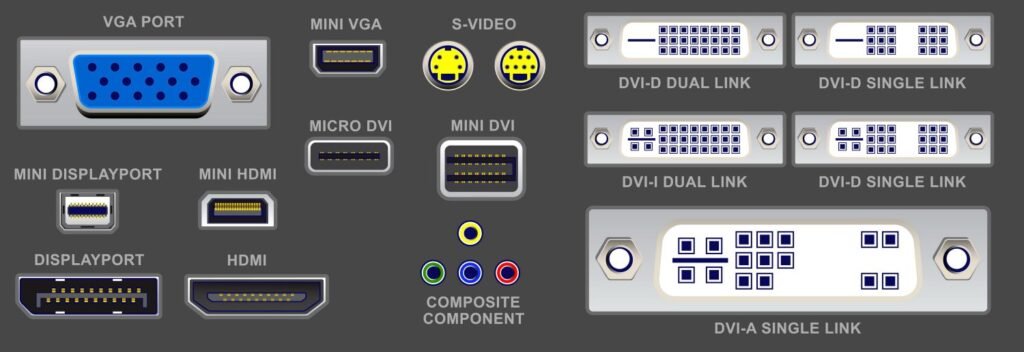In the world of digital displays, HDMI and DisplayPort are two of the most commonly used interfaces for transmitting video and audio signals. While both serve similar purposes, they have distinct differences in terms of performance, compatibility, and features.
Both HDMI (High-Definition Multimedia Interface) and DisplayPort serve the same fundamental purpose—transmitting audio and video signals between devices. However, they are designed for different use cases, and understanding their differences will help you make the best decision.
On This Page
Table of Contents
What is HDMI?
HDMI is the most common audio-video interface used in consumer electronics. From televisions and gaming consoles to streaming devices and laptops, HDMI is practically everywhere.
Key Features of HDMI:
- Designed for home entertainment: Found in TVs, projectors, and gaming consoles.
- Supports both audio and video: No need for a separate audio cable.
- Consumer-friendly: Plug-and-play functionality without complex settings.
Versions of HDMI and Their Advancements:
| HDMI Version | Max Resolution & Refresh Rate | Max Bandwidth | Key Features |
|---|---|---|---|
| HDMI 1.4 | 4K at 30Hz | 10.2 Gbps | Basic 4K support, ARC (Audio Return Channel) |
| HDMI 2.0 | 4K at 60Hz | 18 Gbps | Improved refresh rates, HDR (High Dynamic Range) |
| HDMI 2.1 | 8K at 60Hz, 4K at 120Hz | 48 Gbps | VRR (Variable Refresh Rate), eARC (Enhanced Audio Return Channel) |
Example of HDMI in Use:
If you own a PlayStation 5 or Xbox Series X, using an HDMI 2.1 cable is essential to experience 4K gaming at 120Hz with HDR enabled.
What is DisplayPort?
DisplayPort (DP) is a more powerful alternative, mainly used in computer monitors and professional settings. Developed by VESA (Video Electronics Standards Association), DisplayPort is designed with higher bandwidth in mind, making it ideal for gaming and professional tasks.
Key Features of DisplayPort:
- Higher bandwidth: Can support higher resolutions and refresh rates.
- Better for gaming and multi-monitor setups.
- Supports adaptive sync technologies like G-Sync and FreeSync.
Versions of DisplayPort and Their Advancements:
| DisplayPort Version | Max Resolution & Refresh Rate | Max Bandwidth | Key Features |
|---|---|---|---|
| DisplayPort 1.2 | 4K at 60Hz | 17.28 Gbps | Multi-stream transport (MST) for daisy-chaining displays |
| DisplayPort 1.4 | 8K at 60Hz | 32.4 Gbps | HDR10 support, better compression |
| DisplayPort 2.0 | 16K at 60Hz, 8K at 120Hz | 80 Gbps | Supports multiple 4K monitors at 144Hz |
Example of DisplayPort in Use:
If you’re a PC gamer using an NVIDIA RTX 4090 graphics card, using DisplayPort 1.4 or higher is recommended to achieve 4K at 144Hz with G-Sync enabled.

HDMI vs DisplayPort: Key Differences
While both cables transmit audio and video, they have critical differences:
| Feature | HDMI | DisplayPort |
|---|---|---|
| Designed For | Home entertainment | Gaming & professional monitors |
| Max Bandwidth | 48 Gbps (HDMI 2.1) | 80 Gbps (DP 2.0) |
| Max Resolution & Refresh Rate | 8K at 60Hz, 4K at 120Hz | 16K at 60Hz, 8K at 120Hz |
| Audio Support | eARC for high-quality audio | Supports audio but not as advanced as eARC |
| Adaptive Sync | VRR for consoles | G-Sync & FreeSync for PC gaming |
| Multi-Monitor Support | Limited | Supports daisy-chaining |
Which One Should You Choose?
- If you’re using a gaming console, go with HDMI.
- If you’re a PC gamer or professional, DisplayPort is better.
- If you need multi-monitor setups, DisplayPort is the clear winner.
Gaming and Professional Use: Which One is Better?
For Gamers:
- Consoles (PS5, Xbox) → Use HDMI 2.1.
- PC Gaming (High Refresh Rate Monitors) → Use DisplayPort 1.4 or higher.
- VR Headsets → DisplayPort is preferred due to its higher bandwidth.
For Professional Use (Graphic Designers, Video Editors):
- If you work with color grading and high-resolution video editing, DisplayPort 2.0 is ideal due to its superior bandwidth.
- If you need multi-monitor setups, DisplayPort allows you to daisy-chain multiple screens, reducing cable clutter.
Cable Types and Connectivity
HDMI Cable Types:
- Standard HDMI: 1080p at 60Hz
- High-Speed HDMI: 4K at 30Hz
- Ultra-High-Speed HDMI: 8K at 60Hz, 4K at 120Hz
DisplayPort Cable Types:
- Standard DisplayPort: Supports resolutions up to 4K at 60Hz
- DisplayPort 1.4+: 8K and higher resolutions
- Mini DisplayPort: A smaller connector used in older MacBooks and laptops
Adapters and Cross-Compatibility:
- You can convert DisplayPort to HDMI, but you may lose some features.
- HDMI to DisplayPort requires an active adapter, as HDMI cannot provide the necessary power.
Future of HDMI and DisplayPort
Both HDMI and DisplayPort are constantly evolving:
- HDMI 2.1 is widely adopted in TVs and gaming consoles, ensuring high refresh rates and better audio.
- DisplayPort 2.0/2.1 is set to revolutionize gaming and professional setups with 16K support.
Which One Will Dominate the Future?
- For home entertainment, HDMI will remain the dominant standard.
- For gaming and professional displays, DisplayPort is the future due to its higher bandwidth and multi-monitor capabilities.
WrapUP: Choosing the Right Cable for Your Needs
The battle between HDMI and DisplayPort is not about which is better overall, but rather which is better for your specific needs.
- If you’re a console gamer, stick with HDMI 2.1.
- If you’re a high-refresh-rate PC gamer or professional, go for DisplayPort 1.4 or 2.0.
- If you need multiple displays, DisplayPort is the clear winner.
By understanding their differences, you can make an informed decision that enhances your gaming, streaming, and professional work. Choose wisely, and enjoy your ultra-smooth display experience!
Additional resources :

FAQs
Can I use HDMI and DisplayPort interchangeably?
Not always. While both transmit audio and video signals, their capabilities differ. HDMI is more common in TVs and gaming consoles, whereas DisplayPort is preferred for high-performance PC monitors and multi-display setups.
Which is better for gaming, HDMI or DisplayPort?
For PC gaming, DisplayPort is better because it supports higher refresh rates and adaptive sync technologies like G-Sync and FreeSync. However, for console gaming (PS5, Xbox Series X), HDMI 2.1 is the best choice.
Does DisplayPort carry audio like HDMI?
Yes, DisplayPort supports audio just like HDMI. However, HDMI 2.1’s eARC (Enhanced Audio Return Channel) provides better support for high-quality sound systems, making it ideal for home theater setups.
Can I connect DisplayPort to an HDMI port using an adapter?
Yes, but you may lose some features. A DisplayPort-to-HDMI adapter allows you to connect a DisplayPort source to an HDMI display, but you may be limited in resolution or refresh rate. For HDMI-to-DisplayPort conversion, you need an active adapter, as HDMI does not provide the necessary power.
Is HDMI 2.1 better than DisplayPort 1.4?
It depends on the use case:
For gaming consoles and TVs, HDMI 2.1 is better due to 8K at 60Hz and 4K at 120Hz support.
For PC gaming and professional use, DisplayPort 1.4 or 2.0 is superior due to higher bandwidth and support for multi-monitor setups.
Which cable should I use for a 144Hz monitor?
For 1080p at 144Hz → HDMI 2.0 or DisplayPort 1.2+
For 1440p at 144Hz → DisplayPort 1.2 or higher
For 4K at 144Hz → DisplayPort 1.4 or HDMI 2.1 (check monitor support)
Can I use DisplayPort for a TV?
Most TVs do not have DisplayPort inputs, as HDMI is the standard for home entertainment. However, some high-end TVs may support USB-C to DisplayPort adapters for PC connectivity.
Is DisplayPort the future of gaming?
Yes, for PC gaming, DisplayPort is leading due to its higher bandwidth and support for multiple monitors. However, for console gaming and home entertainment, HDMI will likely remain dominant.
Does HDMI support daisy-chaining multiple monitors like DisplayPort?
No, only DisplayPort supports daisy-chaining using Multi-Stream Transport (MST). HDMI does not have this feature, requiring external splitters for multiple displays.
Which is more widely supported, HDMI or DisplayPort?
HDMI is more widely supported across TVs, gaming consoles, projectors, and streaming devices. DisplayPort is primarily found in PC monitors, high-end laptops, and graphics cards.







